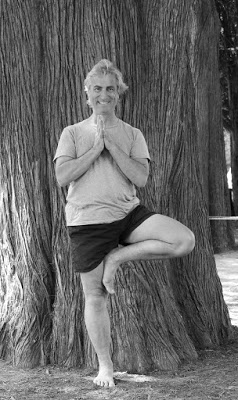by Nina
 |
| Richard Rosen, Age 67, by Melina Meza |
Just a quick post today to let you know about two recent studies on yoga for Parkinson’s disease. Parkinson’s disease (PD) is a progressive neurodegenerative disorder that is prevalent in 1% of people over 60. Symptoms include tremor, rigidity, slowness of movement, and postural instability. In addition, people with PD have neuropsychiatric symptoms that affect mood, sleep, psychosis, and impulse control. There is no cure for PD and the medication currently used to treat symptoms loses effectiveness over time and also has serious side effects. So there is a serious need for people with PD for alternative therapies, such as yoga, to improve their functioning and quality of life.
The first study Effect of Yoga on Motor Function in People with Parkinson’s Disease: A Randomized, Controlled Pilot Study was a small pilot study designed to determine whether yoga could help improve motor function in people with PD. Remember, a pilot study is small because the intention is to find proof of concept before investing in a larger study. So the participants in the study were just thirteen adults with PD who were unfamiliar with yoga. The yoga program used for the study was an 60-minute Iyengar sequence that was specifically designed for people with PD to help improve “strength, flexibility, body alignment, and overall well-being.” The sequence included physical postures, breathing, and meditation. The participants practiced the sequence twice a week for 12 weeks.
The participants were assessed three times by the researchers: before starting the program, at 6 weeks of pratice, and immediately following 12 weeks of practice. The assessments included motor examination scores from the Unified Parkinson’s Disease Rating Scale, posture, measures of extremity range of motion, flexibility, and strength, and measures of balance and gait. The researchers concluded:
“Findings suggest that yoga practice improves motor function which may be partially explained by improvements in balance, strength, posture and gait. Due to the progressive nature of PD yoga programs may offer a way to maintain wellness and perhaps quality of life.”
The second study Applications of yoga in Parkinson’s disease: a systematic literature review focused on the impact of yoga both on physical functioning and psychological well-being in people with PD. This study was a systematic literature review, which means rather than doing original research, the researchers performed a literature search for randomized controlled trials, pretest–post-test design, and case studies. They reviewed studies that had outcomes focused on functional mobility, flexibility, balance, strength, depression, sleep, and quality of life. According to the researchers:
“The preliminary data suggested that yoga resulted in modest improvements in functional mobility, balance, and lower-limb strength in persons with PD. This has implications for gait, postural stability, balance confidence, and functional declines related to inactivity. An improved upper- and lower-body flexibility following yoga in persons with PD is applicable to rigidity, shuffling gait, and flexed posture. The presented evidence also showed positive outcomes for mood and sleep, demonstrating yoga’s benefit for self-efficacy and social support.”
These researchers concluded that yoga indeed provided “an alternative method” both for treating reversible symptoms that affect physical functioning and for improving psychological well-being in people with PD.
Although more research is necessary for full proof, these two studies are very promising. And we already know from anecdotal evidence that yoga is very beneficial for people with PD (see Yoga for Parkinson’s Disease, Part 1 and Interview with Vickie Russell Bell). So if you are already practicing, by all means keep it up. And if you have not yet started to take yoga for PD, perhaps these studies will encourage you to find a suitable class or teacher in your community.
And thanks to all you teachers out there who are specializing in teaching for this group. You’re doing such important work!
Follow Yoga for Healthy Aging on Facebook ° To order Yoga for Healthy Aging: A Guide to Lifelong Well-Being, go to Amazon, Shambhala, Indie Bound or your local bookstore.


Into pd about 6 yrs., I can tell a slight difference with yoga—especially with my incredible yogi. And, both my neuro and internist say they know it helps for certain.